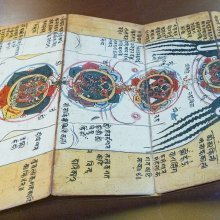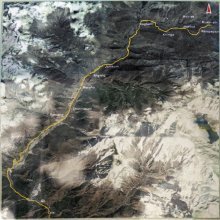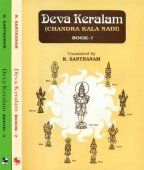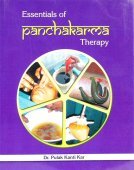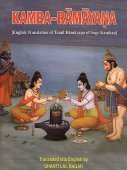Nadi, Nādi, Nadī, Nāḍī, Nādin, Nāḍi, Nadin: 51 definitions
Introduction:
Nadi means something in Buddhism, Pali, Hinduism, Sanskrit, Jainism, Prakrit, the history of ancient India, Marathi, Hindi. If you want to know the exact meaning, history, etymology or English translation of this term then check out the descriptions on this page. Add your comment or reference to a book if you want to contribute to this summary article.
Images (photo gallery)
In Hinduism
Yoga (school of philosophy)
Source: Typepad: Mudras for PranayamaNadi refers to the “flowing currents of energy in the body”.—The root of nadi is nad, which in Sanskrit means, “to flow”. So nadis are the flowing currents of energy in the body. They are energy centers in the body so are actual physical organs. The origin point of the nadis is called the medhra and is located between muladhara and manipura chakras.
Source: ORA: Amanaska (king of all yogas): A Critical Edition and Annotated Translation by Jason Birch1) Nāḍī (नाडी) refers to the “channels of vitality”, according to the Dattātreyayogaśāstra 67c-d-69a-b:—Accordingly, “When purification of the channels (nāḍi-śuddhi) occurs, signs manifest externally on the Yogin’s body. I shall mention all of them; lightness of body, radiance, an increase in digestive fire and then leanness of the body should certainly arise”.
2) Nāḍī (नाडी) refers to Unit of Time (possibly corresponding to twenty-four minutes), according to the Amanaska Yoga treatise dealing with meditation, absorption, yogic powers and liberation.—Accordingly, as Īśvara says to Vāmadeva: “[...] [Now], I shall define the nature of that highest, mind-free absorption which arises for those devoted to constant practice. [...] Remaining in absorption for the [following] times; moments, breaths, Palas, Nāḍīs, Praharas, days, months and years, [the Yogin] then goes to the highest reality. [...]”.
Note: A nāḍī appears to be a synonym for ghaṭikā (i.e., twenty-four minutes) which fits between a pala (i.e., twenty-four seconds) and a prahara (i.e., three hours). A ghaṭikā is defined in Amanaska 1.35. As a unit of time, the term nāḍī is not found elsewhere in the Amanaska, and in the following verses ghaṭikā is used instead. The use of nāḍī and ghaṭikā as synonyms is attested elsewhere; e.g., Bhāskara's Siddhāntaśiromaṇi, verse 17a-b in the Kālamānādhyāya of the Madhyamādhikāra.

Yoga is originally considered a branch of Hindu philosophy (astika), but both ancient and modern Yoga combine the physical, mental and spiritual. Yoga teaches various physical techniques also known as āsanas (postures), used for various purposes (eg., meditation, contemplation, relaxation).
Ayurveda (science of life)
Rasashastra (Alchemy and Herbo-Mineral preparations)
Source: ORA: Amanaska (king of all yogas): (rasashaastra)Nāḍī (नाडी) or Nāḍīvedha refers to one of the Eight Vedhas (of piercing the body) (associated with dehasiddhi), according to the Rasārṇava (vere 18.147-49).—[...] There are, indeed, alchemical procedures which transform bodily constituents but do not involve “eating Dhātus” nor moving vitality (and thus seem unrelated to Amanaska 2.32c). One such example is the eight kinds of piercing the body [e.g., nāḍī-vedha], which are described in connection with dehasiddhi in Rasārṇava.
Unclassified Ayurveda definitions
Source: Wisdom Library: Āyurveda and botanyNāḍī (नाडी) is a Sanskrit word referring to Corchorus olitorius (tossa jute), from the Malvaceae family. It is also known as Nāḍīśāka. Certain plant parts of Nāḍī are eaten as a vegetable (śāka), according to Caraka in his Carakasaṃhitā sūtrasthāna (chapter 27), a classical Ayurvedic work. The plant is therefore part of the Śākavarga group of medicinal plants, referring to the “group of vegetables/pot-herbs”. It is speculated the plant originates from the Indo-Burmese area or from India, along with several other related species.
Source: Google Books: Essentials of AyurvedaNāḍī (नाडी, “nerves”) are wiry structures attached to brain and spinal cord. They, spreading all over the body, carry sensation and control the movements.

Āyurveda (आयुर्वेद, ayurveda) is a branch of Indian science dealing with medicine, herbalism, taxology, anatomy, surgery, alchemy and related topics. Traditional practice of Āyurveda in ancient India dates back to at least the first millenium BC. Literature is commonly written in Sanskrit using various poetic metres.
Vyakarana (Sanskrit grammar)
Source: Wikisource: A dictionary of Sanskrit grammarNadī (नदी).—A technical term applied in Panini's grammar to words in the feminine gender ending in ई (ī) and ऊ (ū) excepting a few like स्त्री,श्री, भ्रू (strī, śrī, bhrū) and others; it is optionally applied to words ending in इ (i) and उ (u), of course in the fem. gender, before case affixes of the dative, ablative, genitive and locative sing. The term was probably in use before Panini and was taken from the fem. word नदी (nadī) which was taken as a model. Very probably there was a long list of words like नद् (nad) (नदट् (nadaṭ)) चोर (cora) (चोरट् (coraṭ)) etc. which were given as ending in ट् (ṭ) and to which the affix ई (ī) (ङीप् (ṅīp)) was added for forming the feminine base;the first word नदी (nadī) so formed, was taken as a model and all words in the list and similar others were called नदी (nadī); cf. P. I 4. 3-6.
--- OR ---
Nādi (नादि).—(a root) beginning with न् (n) in the Dhatupatha as contrasted with one beginning with ण् (ṇ) (णादि (ṇādi)) whose ण् (ṇ) is, of course, changed into न् (n) when conjugational and other forms are arrived at; cf. सर्वे नादयो णोपदेशा नृतिनन्दिनदिनक्किनाटिनाथृनाधृनॄवर्जम् (sarve nādayo ṇopadeśā nṛtinandinadinakkināṭināthṛnādhṛnṝvarjam) M.Bh. on VI. 1.65.
Source: Wikisource: A dictionary of Sanskrit grammarNādin (नादिन्).—Possessed of नाद (nāda); sonorous, resonant, See नाद (nāda). 26
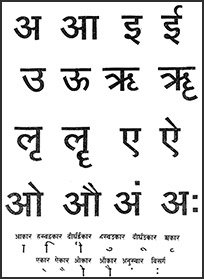
Vyakarana (व्याकरण, vyākaraṇa) refers to Sanskrit grammar and represents one of the six additional sciences (vedanga) to be studied along with the Vedas. Vyakarana concerns itself with the rules of Sanskrit grammar and linguistic analysis in order to establish the correct context of words and sentences.
Natyashastra (theatrics and dramaturgy)
Source: Wisdom Library: Nāṭya-śāstraNadī (नदी) is the name of a meter belonging to the Anuṣṭubh class of Dhruvā (songs) described in the Nāṭyaśāstra chapter 32:—“the metre which has in its feet of eight syllables the first and the final one long, is nadī”.

Natyashastra (नाट्यशास्त्र, nāṭyaśāstra) refers to both the ancient Indian tradition (shastra) of performing arts, (natya—theatrics, drama, dance, music), as well as the name of a Sanskrit work dealing with these subjects. It also teaches the rules for composing Dramatic plays (nataka), construction and performance of Theater, and Poetic works (kavya).
Jyotisha (astronomy and astrology)
Source: Wisdom Library: Brihat Samhita by Varahamihira1) Nāḍī (नाडी) refers to one-sixtieth of a solar day (or 24 minutes), according to the Bṛhatsaṃhitā (chapter 2), an encyclopedic Sanskrit work written by Varāhamihira mainly focusing on the science of ancient Indian astronomy astronomy (Jyotiṣa).—Accordingly, “We shall now proceed to give a brief description of (the qualifications of) a jyotiṣaka. [...] He must have a correct, knowledge of a yuga (43,20,000 Solar years), varṣa (a solar year), āyana (6 solar months), ṛtu (2 solar months), māsa (a solar month), pakṣa (15 solar days), ahorātra (a solar day), yama (one-eighth of a solar day), muhūrta (one-thirtieth of a solar day), nāḍī (one-sixtieth of a solar day or 24 minutes), vināḍi (one sixtieth of a nāḍī or 24 seconds), prāṇa (4 seconds) truṭi (33, 75th of a second) and parts of a truṭi and other divisions of time and also of divisions of space”.
2) Nadī (नदी) refers to “rivers”, according to the Bṛhatsaṃhitā (chapter 5).—Accordingly, “If there should be both lunar and solar eclipses in one month, princes will suffer both from dissensions among their own army and from wars. [...] If the eclipses should fall in the lunar month of Āṣāḍha, wells, wet fields and rivers [i.e., nadī] will become dry; dealers in roots and fruits, the people of Gāndhāra, of Kāśmīra, of Pulinda and of Cīna (China) will perish; and there will be abundance of rain”.
Source: Wikibooks (hi): Sanskrit Technical TermsNāḍī (नाडी).—Unit of time equivalent to 24 minutes. Note: Nāḍī is a Sanskrit technical term used in ancient Indian sciences such as Astronomy, Mathematics and Geometry.

Jyotisha (ज्योतिष, jyotiṣa or jyotish) refers to ‘astronomy’ or “Vedic astrology” and represents the fifth of the six Vedangas (additional sciences to be studied along with the Vedas). Jyotisha concerns itself with the study and prediction of the movements of celestial bodies, in order to calculate the auspicious time for rituals and ceremonies.
Shaktism (Shakta philosophy)
Source: Google Books: Manthanabhairavatantram1) Nāḍī (नाडी) refers to “vital channels”, according to the commentary on the Manthānabhairavatantra, a vast sprawling work that belongs to a corpus of Tantric texts concerned with the worship of the goddess Kubjikā.—Accordingly, as Bhairava promises Himavat: “[...] You (will be the) lord, whose form is the sacrifice which is the dissolving away (of the vital breath) above and below. (Seated) where the (vital) channels (nāḍī) of embodied beings are established in the vital breath, you will convey it”.
2) Nādi (नादि) refers to the letters beginning with Na, according to the second recension of the Yogakhaṇḍa of the Manthānabhairavatantra.—Accordingly, “In the meantime, once the goddess had crossed over the most excellent Yoga and once the fifth night had passed, she emerged from the middle of the Liṅga. [...] The mass of radiance from (her) garland is associated with the letters (of the Mālinī alphabet) beginning with Na and ending with Pha [i.e., nādi-phānta-akṣara-yutā] and, endowed with the fifty rays (of the energies of the letters), she is marked with a garland of flames, has light brown, dishevelled hair, and loves snakes. [...]”.
3) Nadī (नदी) refers to “rivers” or “rivulets”, according to the Ṣaṭsāhasrasaṃhitā, an expansion of the Kubjikāmatatantra: the earliest popular and most authoritative Tantra of the Kubjikā cult.—Accordingly, “The venerable great lord of Oḍra resides in the cavity in the Middle Land. It is (Oḍḍiyāna) the first (sacred seat) and, yellow in colour, it has mountains, forests, and groves, large and small, and is adorned with golden walls. It has rivers and rivulets [i.e., nadī-nada-samākīrṇa] and many (other) things. It is full of all the seeds and is square all around. It has thunderbolts as door chains and Mālinī (who resides there) holds a thunderbolt (vajra) in her hand. Endowed with the sovereignty of the Wheels, it is the sacred seat (Udyāna) attended by the mistress of the sacred seat”.
4) Nādin (नादिन्) [?] means “resounding”, according to the Manthānabhairavatantra.—Accordingly, “Candramaṅgalyā (Jñānamaṅgalā) is in the south-west. She sits on an owl. She has one face and three eyes. She has matted hair, which is (adorned with a) Half Moon. She holds a pestle and trident in her left and right hands, respectively. She wears a garment of human skin and she resounds with the sound of (her) anklets [i.e., nādin—nūpuradhvaninādin]. When the goddess is worshipped in the south-west she consumes inauspicious accidents”.
Source: academia.edu: The Śāradātilakatantra on YogaNāḍī (नाडी, “subtle channel”) is explained in terms of kuṇḍalinīyoga by Lakṣmaṇadeśika in his 11th-century Śaradātilaka.—The body is described, starting from the “bulb” (kanda), the place in which the subtle channels (nāḍī) originate, located between anus and penis (28–9). The three principal channels are iḍā (left), piṅgalā (right) and suṣumṇā (in the centre of the spine and the head). Inside the suṣumṇā is citrā, a channel connecting to the place on the top of the skull called the brahmarandhra (30–4).

Shakta (शाक्त, śākta) or Shaktism (śāktism) represents a tradition of Hinduism where the Goddess (Devi) is revered and worshipped. Shakta literature includes a range of scriptures, including various Agamas and Tantras, although its roots may be traced back to the Vedas.
Shaivism (Shaiva philosophy)
Source: academia.edu: The Śaiva Yogas and Their Relation to Other Systems of YogaNāḍi (नाडि, “channel”) refers to one of the sixteen types of “locus” or “support” (ādhāra) according to the Netratantra. These ādhāras are called so because they “support” or “localise” the self and are commonly identified as places where breath may be retained. They are taught in two different setups: according to the tantraprakriyā and according to the kulaprakriyā. Nāḍi belongs to the latter system.
Source: Brill: Śaivism and the Tantric TraditionsNāḍī (नाडी) refers to the “channels of the body”, according to the Brahmayāmala-tantra (or Picumata), an early 7th century Śaiva text consisting of twelve-thousand verses.—[The padmamālā-vidhi prescribes installing deities within series of nine, seven and eight lotuses].—While the Brahmayāmala does not treat the lotus garlands as fixtures of a subtle body, it does posit the existence of such structures: the body’s channels (nāḍī) and vital airs (vāyu, prāṇa), for instance, and more pertinently, points known as granthis (“knots” or “joints”). A particular series of nine granthis forms the locus for installing the nine lotuses of the primary padmamālā. That granthis were considered to be anatomical realities is suggested by their treatment as points in the body rather than as objects to be placed/installed in the body or engendered through meditation. [...]
Source: SOAS University of London: Protective Rites in the Netra TantraNāḍī (नाडी) refers to the “channels”, according to the Netratantra of Kṣemarāja: a Śaiva text from the 9th century in which Śiva (Bhairava) teaches Pārvatī topics such as metaphysics, cosmology, and soteriology.—Accordingly, [verse 6.6-8]—“The method (upāya) is threefold: gross (sthūla), subltle (sūkṣma), and highest (para). The sthūla [method consists of] sacrifice, oblation, mantra recitation, [and] meditation, together with mudrās, the mohanayantras, and so forth. The king of mantras [i.e., oṃ juṃ saḥ] brings about [relief]. The sukṣma [method contains] yoga of the Cakras, etc., and by upward momentum [of breath] through the channels (kalānāḍī-udaya). The para [method], is Mṛtyujit, which is universal and bestows liberation”.

Shaiva (शैव, śaiva) or Shaivism (śaivism) represents a tradition of Hinduism worshiping Shiva as the supreme being. Closely related to Shaktism, Shaiva literature includes a range of scriptures, including Tantras, while the root of this tradition may be traced back to the ancient Vedas.
Purana and Itihasa (epic history)
Source: Wisdom Library: Skanda-puranaNadī (नदी) refers to “rivers”, according to the Skandapurāṇa 2.2.13 (“The Greatness of Kapoteśa and Bilveśvara”).—Accordingly: as Jaimini said to the Sages: “[...] [Dhūrjaṭi (Śiva)] went to the holy spot Kuśasthalī. He performed a very severe penance near Nīla mountain. [...] By the power of his penance that holy spot became one comparable to Vṛndāvana, the forest near Gokula. Its interior was rendered splendid by lakes, ponds, reservoirs and rivers [i.e., nadī]. It was full of different kinds of trees and creepers (laden) with fruits and flowers of all seasons. It was resonant with the humming sounds of bees inebriated with honey. It was full of different kinds of flocks of birds. It was a comfortable place of resort for all creatures. [...]”.
Source: archive.org: Shiva Purana - English TranslationNadī (नदी) refers to “streams”, according to the Śivapurāṇa 2.2.21. Accordingly as Brahmā narrated to Nārada:—“[...] When Kāma (God of Love) reached the vicinity of Śiva, Spring spread all his splendour in accord with the inclination of the lord. [...] In this atmosphere, on that excellent mountain, Lord Śiva sported about for a long time among the groves (chanda), hedges (nikuñja) and streams (nadī) in the company of Satī”.
Source: valmikiramayan.net: Srimad Valmiki RamayanaNadī (नदी) refers to “rivers” (in the forest), according to the Rāmāyaṇa chapter 2.28. Accordingly:—“[...] soothening with kind words to Sītā, when eyes were blemished with tears, the virtuous Rāma spoke again as follows, for the purpose of waking her turn back: ‘[...] Snakes dwelling in rivers (nadī), moving crookedly like rivers (nadī-kuṭila), stay obstructing the pathways. Hence, living in forest is a great misery’”.

The Purana (पुराण, purāṇas) refers to Sanskrit literature preserving ancient India’s vast cultural history, including historical legends, religious ceremonies, various arts and sciences. The eighteen mahapuranas total over 400,000 shlokas (metrical couplets) and date to at least several centuries BCE.
General definition (in Hinduism)
Source: archive.org: Vedic index of Names and Subjects1) Nadī (नदी, ‘stream’) is mentioned in the Rigveda and later. Reference is made to shallows (gādha) in the river’s bed, to the opposite bank (pāra), and to the bathing of horses in streams. Rivers are also mentioned in close connexion with mountains. The title Nadīpati, ‘lord of rivers’, is once used to express ‘ocean’ or ‘sea-water’.
2) Nāḍī (नाडी) denotes a ‘vein’ or ‘artery’ in the human body in the Atharvaveda and later, a natural extension of the literal sense of ‘reed’.
3) Nāḍī (नाडी) means a musical instrument, a ‘reed flute’, in the Rigveda as well as the Kāṭhaka-saṃhitā, where in one passage it is mentioned along with the Tūṇava.
4) Nāḍī (नाडी) in the Yajurveda-saṃhitās seems to mean the box of the chariot wheel.
In Buddhism
Tibetan Buddhism (Vajrayana or tantric Buddhism)
Source: Wisdom Library: Tibetan BuddhismNadī (नदी) refers to a group of deities summoned by the Yamāntaka-mantra and mentioned as attending the teachings in the 6th century Mañjuśrīmūlakalpa: one of the largest Kriyā Tantras devoted to Mañjuśrī (the Bodhisattva of wisdom) representing an encyclopedia of knowledge primarily concerned with ritualistic elements in Buddhism. The teachings in this text originate from Mañjuśrī and were taught to and by Buddha Śākyamuni in the presence of a large audience (including Nadī).
Source: ORA: Amanaska (king of all yogas): (Tibetan Buddhism)Nadī (नदी) refers to a “river”, according to verse 14.24bd-27 of the Laghuśaṃvara, an ancient Buddhist Yoginī Tantra.—Accordingly, [while describing the Siddhi of speech]: “The Sādhaka [who has] the Siddhi of speech can certainly attract a king or queen by [merely] thinking [it]. He quickly controls gods, demons and men. When angry, he can kill with his speech and drive away his adversary. The practitioner can thus effect a curse with his speech. And he can stop a river (nadī), a cart, a machine [like a water-wheel,] the ocean, elephants and horses, clouds, a man or bird merely by means of his speech. He achieves everything which he desires by his speech”.

Tibetan Buddhism includes schools such as Nyingma, Kadampa, Kagyu and Gelug. Their primary canon of literature is divided in two broad categories: The Kangyur, which consists of Buddha’s words, and the Tengyur, which includes commentaries from various sources. Esotericism and tantra techniques (vajrayāna) are collected indepently.
Mahayana (major branch of Buddhism)
Source: academia.edu: A Study and Translation of the GaganagañjaparipṛcchāNādin (नादिन्) refers to “one who roars (the lion’s roar)”, according to the Gaganagañjaparipṛcchā: the eighth chapter of the Mahāsaṃnipāta (a collection of Mahāyāna Buddhist Sūtras).—Accordingly, “Then the Brahmā Prabhāvyūha addressed himself to the Lord [...] O Lord, since his former roots of good have been not yet repaid by anyone, that the Bodhisattvas Gaganagañja roars this lion’s roar (siṃhanāda-nādin) in the present time is the outcome of the profound practice in the past’. The Lord said: ‘Quite so, it is just as you have said. The incomparable complete awakening of the Bodhisattvas arises from the former roots of good, merits, and knowledges’”.

Mahayana (महायान, mahāyāna) is a major branch of Buddhism focusing on the path of a Bodhisattva (spiritual aspirants/ enlightened beings). Extant literature is vast and primarely composed in the Sanskrit language. There are many sūtras of which some of the earliest are the various Prajñāpāramitā sūtras.
In Jainism
General definition (in Jainism)
Source: Encyclopedia of Jainism: Tattvartha Sutra 5: The category of the non-livingNādi (नादि) refers to a unit of time according to the 2nd-century Tattvārthasūtra 5.40.—What is the duration of lava? It is seven stokas. What is the duration of one nādi? It consists of 38.5 lava. What is an Indian-hour (muhūrta)? It consists of two nādis.
Source: The University of Sydney: A study of the Twelve ReflectionsNadī (नदी) refers to a “river”, according to the 11th century Jñānārṇava, a treatise on Jain Yoga in roughly 2200 Sanskrit verses composed by Śubhacandra.—Accordingly, “A line of waves in a river [com.—nadī-kallolāvalī—‘a line of waves in a river’] that has gone somewhere also returns but not for men the handsome form, strength, charm [and] gracefulness that has gone”.
Synonyms: Sarit.

Jainism is an Indian religion of Dharma whose doctrine revolves around harmlessness (ahimsa) towards every living being. The two major branches (Digambara and Svetambara) of Jainism stimulate self-control (or, shramana, ‘self-reliance’) and spiritual development through a path of peace for the soul to progess to the ultimate goal.
India history and geography
Source: Cologne Digital Sanskrit Dictionaries: Indian Epigraphical GlossaryNāḍī.—(IA 7-1-2), ‘three’. Note: nāḍī is defined in the “Indian epigraphical glossary” as it can be found on ancient inscriptions commonly written in Sanskrit, Prakrit or Dravidian languages.

The history of India traces the identification of countries, villages, towns and other regions of India, as well as mythology, zoology, royal dynasties, rulers, tribes, local festivities and traditions and regional languages. Ancient India enjoyed religious freedom and encourages the path of Dharma, a concept common to Buddhism, Hinduism, and Jainism.
Languages of India and abroad
Pali-English dictionary
Source: BuddhaSasana: Concise Pali-English Dictionarynadi : (aor. of nadati) roared; made a noise. || nadī (f.), river.
Source: Sutta: The Pali Text Society's Pali-English DictionaryNādi, (f.)=nāda, loud sound, thundering (fig.) Vv 6410. (Page 349)
— or —
Nadī, (f.) (Ved. nadī, from nadati=“the roaring, ” cp. also nandati) a river; often characterised as mahā° in opp. to kun° rivulet; pl. nadiyo also collect. “the waters. ” — D. I, 244 (Aciravatī nadī); S. II, 32, 118, 135; V, 390; A. I, 33, 136, 243 (mahā°); II, 55, 140 (mahā°); III, 52; IV, 101 (m°), 137; Sn. 425, 433, 568, 720; Dh. 251; J. I, 296; II, 102; III, 51; III, 91 (Kebukā); V, 269 (Vetaraṇī°); VI, 518 (Ketumatī); Pv IV. 354; Vism. 468 (sīghasotā); PvA. 256 (m°); Sdhp. 21, 194, 574.—Gen. sg. nadiyā J. I, 278; It. 113; Instr. nadiyā J. I, 278; PvA. 46; pl. Nom. nadiyo Miln. 114 (na tā n. dhuva-salilā), najjo PvA. 29 (mahā°); & najjāyo J. VI, 278; gen nadīnaṃ Vin. I, 246=Sn. 569 (n. sāgaro mukhaṃ).—kunnadī a small river S. I, 109; II, 32, 118; V, 47, 63; A. II, 140; IV, 100; V, 114 sq.—On n. in similes see J. P. T. S. 1906, 100.

Pali is the language of the Tipiṭaka, which is the sacred canon of Theravāda Buddhism and contains much of the Buddha’s speech. Closeley related to Sanskrit, both languages are used interchangeably between religions.
Marathi-English dictionary
Source: DDSA: The Molesworth Marathi and English Dictionarynadī (नदी).—f (S) A river. Pr. nadīcēṃ mūḷa ṛṣīcēṃ kūḷa pāhūṃ nayē.
--- OR ---
nāḍī (नाडी).—f (S) Any tubular organ of the body, an artery, a vein, an intestine &c. 2 The stalk, culm, or haum of a plant. 3 The tape of the waist of a garment. It is a piece of a marked off length, about four feet: also that material, taping or tape-stuff. 4 A pipe or tube. 5 The pulse (at the hand or foot). 6 An hour of twenty-four minutes. 7 (From the conceit of nāḍī A vein.) A classified division of the table of the lunar asterisms. There are three, each containing nine asterisms. They are named ādināḍī, madhyanāḍī, antyanāḍī. 8 A specific duct or canal in the system, of which it pleaseth the Hindus to reckon three; viz. kaphanāḍī, pittanāḍī, vātanāḍī. nāḍī ākarṣaṇa karaṇēṃ-hōṇēṃ-gōḷā karaṇēṃ &c. To draw up as in dying; and fig. To ruin or be ruined.
--- OR ---
nādī (नादी).—a (nāda) That is taken up or engrossed by (any object of desire or interest): also that dangles after, dances attendance upon, hangs upon.
Source: DDSA: The Aryabhusan school dictionary, Marathi-Englishnadī (नदी).—f A river.
--- OR ---
nāḍī (नाडी).—f Any tubular organ of the body, an artery, a vein. The stalk of a plant. The tape of the waist of a garment. A pipe or tube. The pulse (at the hand or foot). An hour of twenty-four minutes. A classified division of the table of the lunar asterisms. nāḍī ākarṣaṇa karaṇēṃ-hōṇēṃ-gōḷā karaṇēṃ &c. To draw up as in dying; to ruin or be ruined.
--- OR ---
nādī (नादी).—a That is taken up or engrossed by (any object of desire or interest). That dances attendance upon, hangs upon.
Marathi is an Indo-European language having over 70 million native speakers people in (predominantly) Maharashtra India. Marathi, like many other Indo-Aryan languages, evolved from early forms of Prakrit, which itself is a subset of Sanskrit, one of the most ancient languages of the world.
Sanskrit dictionary
Source: DDSA: The practical Sanskrit-English dictionaryNadi (नदि).—Ved. Praise.
Derivable forms: nadiḥ (नदिः).
--- OR ---
Nadī (नदी).—A river, any flowing stream; रविपीतजला तपात्यये पुनरोघेन हि युज्यते नदी (ravipītajalā tapātyaye punaroghena hi yujyate nadī) Kumārasambhava 4.44; यथा नद्यः स्यन्दमानाः समुद्रेऽ स्तं गच्छन्ति नामरूपे विहाय (yathā nadyaḥ syandamānāḥ samudre' staṃ gacchanti nāmarūpe vihāya) Muṇḍa.
--- OR ---
Nāḍi (नाडि) or Nāḍī (नाडी).—f.
1) The tubular stalk of any plant.
2) The hollow stalk of a lotus &c; स इत्थमुद्वीक्ष्य तदब्द- नालनाडीभिरन्तर्जलमाविवेश (sa itthamudvīkṣya tadabda- nālanāḍībhirantarjalamāviveśa) Bhāgavata 3.8.19.
3) Any tubular organ of the body (such as an artery, vein); षडधिकदशनाडीचक्रमध्यस्थितात्मा (ṣaḍadhikadaśanāḍīcakramadhyasthitātmā) Mālatīmādhava (Bombay) 5.1,2.
4) A pipe, flute.
5) A fistulous sore, fistula, sinus.
6) The pulse at the hand or foot.
7) A measure of time equal to twenty-four minutes.
8) A period of time = 1/2 Muhūrta.
9) A sort of bent grass.
1) A juggling trick.
11) A leather-string; L. D. B.
12) A weaver's implement; L. D. B.
Derivable forms: nāḍiḥ (नाडिः).
--- OR ---
Nādi (नादि).—a. Sounding, roaring.
Source: DDSA: The practical Sanskrit-English dictionaryNādin (नादिन्).—a.
1) Sounding, resonant; अम्बुदवृन्दनादी रथः (ambudavṛndanādī rathaḥ) Mb.; R.3.59;19.5.
2) Bellowing, roaring; खर°, सिंह° (khara°, siṃha°) &c.
Source: Cologne Digital Sanskrit Dictionaries: Edgerton Buddhist Hybrid Sanskrit DictionaryNadin (नदिन्).—name of a brahman: nadī nāma Mahāvastu iii.325.2. The same personage is referred to, but not named, in Pali, Vin. i.2.32.
Source: Cologne Digital Sanskrit Dictionaries: Shabda-Sagara Sanskrit-English DictionaryNāḍi (नाडि).—f. (-ḍiḥ-ḍī) 1. The stalk or stem of any plant. 2. Any tubular, organ of the body, as an artery, a vein, an intestine, &c. 3. The hollow stalk of a lotus, &c. 4. A fistulous sore, a flstula, a sinus. 5. A sort of bent grass. 6. A juggling trick. 7. Deception. 8. An hour of twenty-four minutes. 9. Any pipe or tube. 10. The pulse, either at the hand or feet, &c. E. naḍ to fall off or from, affix ac and in or ṅīṣ optionally added.
Source: Cologne Digital Sanskrit Dictionaries: Shabda-Sagara Sanskrit-English DictionaryNādin (नादिन्).—mfn. (-dī-dinī-di) Who or what sounds. E. nad to sound, aff ṇini .
Source: Cologne Digital Sanskrit Dictionaries: Benfey Sanskrit-English DictionaryNāḍī (नाडी).—i. e. naḍa + a + ī, also
--- OR ---
Nāḍi (नाडि).— ([Bhāgavata-Purāṇa, (ed. Burnouf.)] 3, 5, 11), f. 1. The stalk or culm of any plant. 2. Any tubular organ of the body, as an artery, a vein, an intestine, etc., Mahābhārata 3, 13974; [Raghuvaṃśa, (ed. Stenzler.)] 10, 59 (the rays of the sun, supposed to be hollow). 3. A fistulous sore, [Suśruta] 1, 284, 11. 4. = nā- ḍikā 1, Sūryas. 1, 12.
Source: Cologne Digital Sanskrit Dictionaries: Benfey Sanskrit-English DictionaryNādin (नादिन्).—i. e. nad or nāda + in, I. adj., f. nī, Sounding, sounding aloud, [Harivaṃśa, (ed. Calc.)] 8069; Mahābhārata 2, 987. Ii. m. a proper name, [Harivaṃśa, (ed. Calc.)] 12941.
Source: Cologne Digital Sanskrit Dictionaries: Cappeller Sanskrit-English DictionaryNadi (नदि).—[masculine] crier, caller.
--- OR ---
Nadī (नदी).—v. nada.
--- OR ---
Nāḍi (नाडि).—[feminine] vein, artery, any tubular organ of the body.
--- OR ---
Nāḍī (नाडी).—[feminine] tube, pipe, flute; cranny, fissure; vein, pulse, etc. (v. nāḍi); wheel-box.
--- OR ---
Nādi (नादि).—[adjective] sounding, noisy.
Source: Cologne Digital Sanskrit Dictionaries: Cappeller Sanskrit-English DictionaryNādin (नादिन्).—[adjective] sounding, roaring, thundering, resonant (often —°).
Source: Cologne Digital Sanskrit Dictionaries: Monier-Williams Sanskrit-English Dictionary1) Nadī (नदी):—[from nada > nad] a f. See nadī.
2) Nadi (नदि):—[from nad] m. a crier, caller, [Ṛg-veda v, 74, 2] (= stuti, [Sāyaṇa])
3) [v.s. ...] mfn. ifc. See nadī.
4) Nadī (नदी):—[from nad] b f. flowing water, a river (commonly personified as a female; but See nada above), [Ṛg-veda] etc. etc. (ifc. nadikā; cf. ku-nadikā and giri-; ind. -nadi; cf. upa-nadi [beside -nadam, [from] nada, [Pāṇini 5-4, 110]])
5) [v.s. ...] Name of 2 kinds of metre, [Colebrooke]
6) [v.s. ...] of [particular] fem. stems ending in ī or ū (as nadī itself), [Pāṇini 1-4, 3, etc.]
7) Nāḍi (नाडि):—[from nāḍa] 1. nāḍi m. the son of Naḍa, [Pāṇini 4-1, 99; Kāśikā-vṛtti]
8) [v.s. ...] 2. nāḍi f. any tube or pipe, ([especially]) a tubular organ (as a vein or artery of the body), [Bhāgavata-purāṇa] (cf. nāḍī).
9) Nāḍī (नाडी):—[from nāḍa] f. ([from] nāḍa [nominative case] ḍīs, [Ṛg-veda x, 135, 7]) the tubular stalk of any plant or any tubular organ (as a vein or artery of the body)
10) [v.s. ...] any pipe or tube, [Ṛg-veda] etc. etc.
11) [v.s. ...] a flute, [Ṛg-veda; Kāṭhaka]
12) [v.s. ...] the box of a wheel, [Taittirīya-saṃhitā; Kāṭhaka]
13) [v.s. ...] a fistulous sore, [Suśruta]
14) [v.s. ...] the pulse, [Horace H. Wilson]
15) [v.s. ...] any hole or crevice, [Kathāsaritsāgara]
16) [v.s. ...] a sort of bent grass (= gaṇḍa-dūrvā), [cf. Lexicographers, esp. such as amarasiṃha, halāyudha, hemacandra, etc.]
17) [v.s. ...] a strap of leather, thong, [cf. Lexicographers, esp. such as amarasiṃha, halāyudha, hemacandra, etc.]
18) [v.s. ...] a measure of time = 1/2 Muhūrta, [Varāha-mihira]
19) [v.s. ...] a juggling trick, deception, [cf. Lexicographers, esp. such as amarasiṃha, halāyudha, hemacandra, etc.]
20) Nādi (नादि):—[from nāda] mfn. sounding, roaring, [Pāraskara-gṛhya-sūtra]
Source: Cologne Digital Sanskrit Dictionaries: Monier-Williams Sanskrit-English Dictionary1) Nādin (नादिन्):—[from nāda] mfn. sounding, resonant, howling, roaring etc.
2) [v.s. ...] ifc. = [preceding] [Mahābhārata; Kāvya literature] etc.
3) [v.s. ...] pronounced with sound, sonant, [Śikṣā]
4) [v.s. ...] m. Name of a Dānava, [Harivaṃśa]
5) [v.s. ...] of a Brāhman changed into an antelope, [ib.]
Source: Cologne Digital Sanskrit Dictionaries: Yates Sanskrit-English DictionaryNāḍi (नाडि):—[(ḍiḥ-ḍī)] 2. 3. f. The stalk of any plant; a tubular vessel; a fistula; the pulse; hour of 24 minutes; a trick.
Source: Cologne Digital Sanskrit Dictionaries: Yates Sanskrit-English DictionaryNādin (नादिन्):—[(dī-dinī-di) a.] Sounding.
Source: DDSA: Paia-sadda-mahannavo; a comprehensive Prakrit Hindi dictionary (S)Nadī (नदी) in the Sanskrit language is related to the Prakrit words: Ṇaī, Ṇāḍi, Ṇāḍī, Ṇālā, Ṇāla, Ṇālī.
[Sanskrit to German]
Sanskrit, also spelled संस्कृतम् (saṃskṛtam), is an ancient language of India commonly seen as the grandmother of the Indo-European language family (even English!). Closely allied with Prakrit and Pali, Sanskrit is more exhaustive in both grammar and terms and has the most extensive collection of literature in the world, greatly surpassing its sister-languages Greek and Latin.
Hindi dictionary
Source: DDSA: A practical Hindi-English dictionary1) Nadī (नदी):—(nf) a river; -[ghāṭī] river valley; -[tala] the river bed; -[nāva saṃyoga] a chance meeting; -[pātra] the river basin; ~[mukha] embouchure, mouth of a river; —[bahānā, khūna kī] to shed a stream of blood, to cause immense bloodshed.
2) Nāḍī (नाडी):—(nf) pulse; vein; artery; -[parīkṣā] feeling of the pulse (by a physician); -[saṃsthāna] the whole system of arteries and veins; —[dekhanā] to feel the pulse of; —[pahacānanā] to be aware of the pulse vibrations of to know thoroughly well.
...
Prakrit-English dictionary
Source: DDSA: Paia-sadda-mahannavo; a comprehensive Prakrit Hindi dictionary1) Ṇaḍī (णडी) in the Prakrit language is related to the Sanskrit word: Naṭī.
2) Ṇāḍi (णाडि) also relates to the Sanskrit word: Nāḍi.
3) Ṇāḍī (णाडी) also relates to the Sanskrit word: Nāḍī.
Prakrit is an ancient language closely associated with both Pali and Sanskrit. Jain literature is often composed in this language or sub-dialects, such as the Agamas and their commentaries which are written in Ardhamagadhi and Maharashtri Prakrit. The earliest extant texts can be dated to as early as the 4th century BCE although core portions might be older.
Kannada-English dictionary
Source: Alar: Kannada-English corpusNaḍi (ನಡಿ):—[verb] = ನಡೆ [nade]1.
--- OR ---
Nadi (ನದಿ):—
1) [noun] a natural stream of water of fairly large size flowing in a definite course and emptying into an ocean, a lake or another river; a river.
2) [noun] ನದೀ ದಾಟಿ ಬದೀಲಿ ಬಿದ್ದ [nadi dati badili bidda] nadī dāṭi badīli bidda (prov.) accomplished a great and very difficult thing but failed in a fairly easy one; jumped over mountains but stumbled while crossing a threshold.
--- OR ---
Nāḍi (ನಾಡಿ):—
1) [noun] the hollow stem of a plant; a culm.
2) [noun] the hollow stalk of a lotus flower.
3) [noun] any blood vessel.
4) [noun] the regular beating in the arteries, caused by the contractions of the heart; pulse.
5) [noun] any astral tube carrying prāṇa or nerve current.
6) [noun] any tube or pipe.
7) [noun] an abnormal passage from an abscess, cavity or hollow organ to the skin or to another abscess, cavity or organ; fistula.
8) [noun] a period of twenty four minutes.
9) [noun] a sort of bent grass.
10) [noun] a secret plan or scheme to accomplish some purpose, esp. a hostile, unlawful or evil purpose.
11) [noun] (yoga) any of the passages that exist in the body for the internal, vital winds.
12) [noun] (fig.) the perceptible underlying feelings of the public or of a situation.
13) [noun] ನಾಡಿ ಆಡು [nadi adu] nāḍiāḍu (an artery) to beat regularly and rhythmically (at certain points of the body); ನಾಡಿ ಆಡದವ ಓಡಿ ಬಂದಾನೆ [nadi adadava odi bamdane]? nāḍiāḍādava ōḍi bandāne (prov.) a dead is dead, will never come back; ನಾಡಿ ನಿಂತ ಮೇಲೆ ಕಾಡ ಪಾಲು [nadi nimta mele kada palu] nāḍi ninta mēle kāḍa pālu (prov.) no one will follow the dead person; ನಾಡಿ ನೋಡು [nadi nodu] nāḍi nōḍu to check the rate and rhythmicity of the pulse-beating; ನಾಡಿ ನೋಡದೆ ಮದ್ದುಕೊಟ್ಟರೆ ಕಾಡುರೋಗ ಬರುವುದು [nadi nodade maddukottare kaduroga baruvudu] nāḍi nōḍade maddu koṭṭare kāḍurōga baruvudu diagnose the disease before treating it; ನಾಡಿ ಮಿಡಿ [nadi midi] nāḍi miḍi = ನಾಡಿ ಆಡು [nadi adu]; ನಾಡಿ ಮಿಡಿತ [nadi midita] nāḍi miḍita the regular beating in the arteries, caused by the contractions of the heart; 2. practical knowledge of underlying feelings of the public or a particular situation; ನಾಡಿ ಹುಣ್ಣು [nadi hunnu] nāḍi huṇṇu = ನಾಡಿ [nadi]1 - 6.
--- OR ---
Nāḍi (ನಾಡಿ):—[noun] an archaic musical instrument.
Kannada is a Dravidian language (as opposed to the Indo-European language family) mainly spoken in the southwestern region of India.
Nepali dictionary
Source: unoes: Nepali-English Dictionary1) Nadī (नदी):—n. fem. river; stream;
2) Nāḍī (नाडी):—n. 1. any tubular organ of the body; 2. the pulse at the hand or foot; 3. nerve of the subtle body; 4. wrist; 5. inner capacity or strength;
3) Nādī (नादी):—adj. 1. sounding; resonant; 2. bellowing; roaring;
Nepali is the primary language of the Nepalese people counting almost 20 million native speakers. The country of Nepal is situated in the Himalaya mountain range to the north of India.
See also (Relevant definitions)
Starts with (+196): Nadi blue grass, Nadi bluegrass, Nadi Kassapa, Nadi Sodhana, Nadi Sutta, Nadi-buda, Nadi-niyantran, Nadi-niyantrana, Nadia, Nadiavatti, Nadibhallataka, Nadibhandagama, Nadibhanga, Nadibhava, Nadibheda, Nadibhinna, Nadibudu, Nadica, Nadica Phatakala, Nadicakra.
Ends with (+369): Abhinadi, Abhranadi, Adanadi, Addanadi, Adnadi, Adyanadi, Aiyanati, Akanadi, Akanati, Alambunadi, Amaranadi, Ambaranadi, Ambunadi, Amshunadi, Anadi, Anakkunadi, Anati, Angaranadi, Anjanadi, Annadi.
Full-text (+875): Svarnadi, Girinadi, Nadimandala, Nadicakra, Cakranadi, Garbhanadi, Nadija, Nadikula, Pratinadi, Pretanadi, Ushnanadi, Nali, Nadimdhama, Nadinakshatra, Nadanadipati, Nadiraya, Nadidatta, Nadika, Nadivanka, Nadimdhaya.
Relevant text
Search found 151 books and stories containing Nadi, Nādi, Nadī, Nāḍī, Nādī, Naḍi, Nādin, Nāḍi, Ṇaḍī, Ṇadī, Ṇāḍi, Ṇāḍī, Nadin, Nadee; (plurals include: Nadis, Nādis, Nadīs, Nāḍīs, Nādīs, Naḍis, Nādins, Nāḍis, Ṇaḍīs, Ṇadīs, Ṇāḍis, Ṇāḍīs, Nadins, Nadees). You can also click to the full overview containing English textual excerpts. Below are direct links for the most relevant articles:
Shat-cakra-nirupana (the six bodily centres) (by Arthur Avalon)
The Agni Purana (by N. Gangadharan)
Chapter 352 - Narration of the finished forms of the substantives in the feminine
Chapter 128 - The Koṭacakra—a drawing to forecast results
Chapter 126 - Combinations of good and bad asterisms (nakṣatra-nirṇaya)
Thirty minor Upanishads (by K. Narayanasvami Aiyar)
Subala Upanishad of Shukla-yajurveda, Chapter IV
Varaha Upanishad of Krishna-Yajurveda, Chapter V
Bhagavatpadabhyudaya by Lakshmana Suri (study) (by Lathika M. P.)
Tāntric Measures < [Chapter 3 - References to Śaṅkara’s Philosophy]
Pūrṇa River < [Chapter 4 - Similarities and Dissimilarities]
Taittiriya Upanishad (by A. Mahadeva Sastri)
Chapter VI - States of Consciousness < [B - Brahmavidyā Explained]
Lesson VI - Contemplation of Brahman < [Book I - Shiksha Valli]
Chapter III - Brahman’s Existence as Jīva < [B - Brahmavidyā Explained]
Related products
